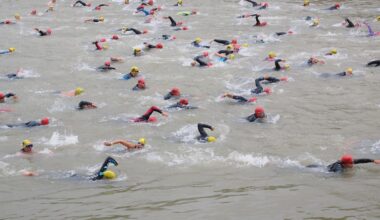Using Resistance Bands in Volleyball Stretching Sessions
Incorporating resistance bands into volleyball stretching routines can significantly enhance flexibility and strength. Resistance bands provide a versatile tool for volleyball players to improve their range of motion through dynamic stretching. Dynamic stretching involves moving parts of your body and gradually increasing reach, speed of movement, or both. Using bands during these movements emphasizes muscle engagement, helps prevent injury, and maintains a balanced workout. To start, identify the areas that require flexibility, such as the shoulders, hips, and legs. By anchoring a resistance band securely, players can perform various stretches targeting specific muscle groups. For instance, using bands for shoulder stretches can enhance overhead mobility crucial for spiking and serving. Similarly, leg stretches with bands improve hip flexibility, key for effective movements like lunging and jumping. Taking these stretches seriously during training sessions helps enhance performance and minimizes the risk of muscle strains. Exploring various resistance band exercises within your routine could shape your game, keeping you strong and agile on the court during intense matches. Developing a stretching routine using resistance bands promotes better performance, agility, and resilience in any volleyball athlete’s training regime.
In addition to enhancing flexibility, resistance bands help develop strength in volleyball players. Strength training is essential for performance in sports like volleyball, where explosive movements are common. Resistance bands provide lightweight yet effective feedback that players can control, allowing for safe strength exercises tailored to individual needs. Exercises such as banded leg lifts, resisted squats, and lateral band walks are ideal for volleyball training. These exercises not only build muscle but also improve coordination, which is vital in a fast-paced sport. As players adapt to the resistance, it’s important to gradually increase the tension to continue challenging the muscles. Incorporating resistance bands into strength training can be a game-changer, especially for young athletes still developing their skills. Additionally, the lightweight nature of bands makes them portable, enabling players to stretch and strengthen on the go. Whether at home, at the gym, or on the court, resistance bands make it easy to commit to an effective workout. By consistently including these stretches in training, players will notice increased coordination, enhanced muscle engagement, and overall improved performance during matches.
Types of Resistance Bands and Their Uses
There are many types of resistance bands, each offering different levels of elasticity and strength. Popular options include flat bands, tube bands with handles, and mini bands. Flat bands are often used for general stretching and rehabilitation workouts, as they can accommodate a wide range of exercises. These bands are versatile, making them fantastic for volleyball players targeting specific muscle groups. Tube bands, often equipped with handles, are ideal for strength training and allow more versatility in exercises. Players can perform arm curls or shoulder rotations easily with tube bands. Mini bands, also known as loop bands, are excellent for resistance training focused on lower body strength. They help activate glute muscles essential for jumping and lateral movements on the court. From warm-up stretches to post-workout routines, each band serves a purpose in training. Volleyball athletes can maximize their strength and flexibility by using a combination of these resistance bands in varying workouts. Emphasizing a balanced routine is critical, thus alternating between different bands to target all muscle groups effectively. This diverse approach will contribute significantly to a player’s overall game and performance success.
Aside from flexibility and strength training, using resistance bands also improves injury prevention strategies for volleyball players. Volleyball involves repetitive motions that can cause strains and injuries over time. Using resistance bands helps to strengthen the smaller stabilizing muscles that traditional weightlifting may neglect. Ensuring comprehensive development of these muscles contributes to injury resistance. Implementation of resistance band exercises into both pre-game warm-ups and recovery sessions can effectively prepare muscles for the demands of game play. Focus on areas such as the rotator cuff, hip flexors, and knees is paramount. These crucial body parts experience high impact during matches and should be carefully conditioned. Resistance bands can also be utilized to rehabilitate existing injuries by increasing stability and enhancing movement quality without adding excessive weight. Incorporating injury prevention exercises can empower volleyball players to stay in shape effectively. As players commit to regular stretching with resistance bands, they may experience fewer injuries and improved recovery times. Thus, fostering a healthier athletic environment and maintaining peak physical condition is achievable through dedicated resistance band routines.
Implementing Resistance Bands into Your Routine
Creating a structured routine that includes resistance bands is crucial for maximizing benefits. Begin with a thorough warm-up session, targeting all muscle groups engaged in volleyball practices. Follow this by incorporating various resistance band stretches tailored to individual needs. For example, players may start with shoulder stretches using bands to improve overhead movements. Transition into leg stretches to promote hip flexibility, which is essential for jumps and lunges. Utilize the medium tensions of resistance bands for strength exercises during training sessions. Progressively increase difficulty as players adapt to their current resistance levels. Aim for at least three sets of six to twelve repetitions in any strength-enhancing workout with bands. Include both upper and lower body exercises to balance muscle engagement. This routine ensures muscle alignment and stability needed for optimal performance during games. Schedule routine sessions at least three times a week, focusing on both flexibility and strength training. By maintaining consistency and dedication, the benefits of resistance band workouts will be evident on the volleyball court, improving overall agility and most importantly, game success.
In conclusion, the integration of resistance bands into volleyball stretching routines is essential for enhancing flexibility, strength, and injury prevention. Volleyball players must recognize the importance of including these versatile bands in their training regimen to maximize potential. Dynamic stretches provide more benefits compared to static stretching alone. Resistance bands allow targeted, muscle-specific engagement, crucial for athletic performance improvement. By developing a habit of consistent routine sessions, athletes will see long-lasting effects on their gameplay. Resistance training prepares the body to react under pressure, a critical aspect of volleyball due to quick, agile movements on the court. Employing the various types of resistance bands strategically ensures a balanced workout that addresses all muscle groups. Integrating these tools in drills will help keep training sessions fresh and engaging. Continually exploring new stretching and strength exercises can keep motivation high while leading to continuous progress. As volleyball athletes invest time and effort into their training, resistance bands can be the key to unlocking their full potential. Consistent practice combined with resistance band exercises will enhance performance, ensuring athletes stay competitive throughout their volleyball careers.
Final Thoughts on Resistance Bands
Embracing resistance bands as part of volleyball training can transform the workout experience. Players who prioritize stretching routines with resistance bands will benefit from enhanced flexibility, muscle engagement, and injury prevention. Volleyball demands physical agility and explosive movement; hence, providing the proper combination of strength and stretcher greatly benefits athletes. Always aim to introduce new exercises into routine sessions to keep the training engaging, and it is essential to adjust resistance levels as fitness improves. A well-structured resistance band routine allows any volleyball player to build a stronger foundation effectively. Coaches and trainers should encourage athletes to explore resistance band workouts to complement their daily practice. As players discover the positive impact of these training tools, they will likely experience increased performance on the court. Encouraging athletes to stretch before and after practices is vital to fostering well-rounded development. Therefore, by making resistance bands a staple in any volleyball training program, athletes can pave their way towards achieving their goals and excelling in their beloved sport. So, grab a band, stretch, strengthen, and enjoy all the benefits that come from this essential training practice.
Ultimately, adopting resistance bands for volleyball stretching enables athletes to improve physical conditioning meaningfully. The emphasis on dynamic stretches can lead to better muscle recovery and reduced injury risks as they enhance athletic performance. Resistance bands can be incorporated into every training segment, ensuring a holistic approach to growth. Players should maintain the determination to push through discomfort while respecting their limits, as this leads to growth. In every session—whether focusing on stretching or strength training—the key is consistency. By integrating these defined parameters into routine practice, volleyball players set themselves up for maximal success and sustainable progress. Always remember that the journey towards improvement takes time and commitment; therefore, players should stay patient and persistent. Progress might reveal itself gradually; however, these small improvements culminate in exceptional performance during competitions. Volleyball is a demanding sport, and with the proper training tools, athletes can manage to rise above their competition. Resistance bands provide a practical bridge to achieving heightened agility, strength, and overall success on and off the court. Taking these insights into consideration positively affects training, pushing both athletes and the sport of volleyball forward.


